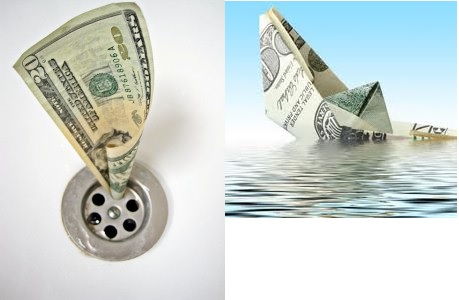Sunk Cost Fallacy
In economics and business decision-making, a sunk cost is a retrospective (past) cost that has already been incurred and cannot be recovered. Sunk costs are sometimes contrasted with prospective costs, which are future costs that may be incurred or changed if an action is taken.
For example, if one is considering pre-ordering movie tickets, but has not actually purchased them yet, the cost remains avoidable. If the price of the tickets rises to an amount that requires him to pay more than the value he places on them, he should figure the change in prospective cost into the decision-making and re-evaluate his decision.
https://en.wikipedia.org/wiki/Sunk_costs
When making business or investment decisions, individuals and organizations typically look at the future costs that they may incur, by following a certain strategy. A company that has spent $5 million building a factory that is not yet complete, has to consider the $5 million sunk, since it cannot get the money back. It must decide whether continuing construction to complete the project will help the company regain the sunk cost, or whether it should walk away from the incomplete project.
https://www.investopedia.com/terms/s/sunkcost.asp
 Sunk Cost Fallacy in our daily lives
Sunk Cost Fallacy in our daily lives
- How many of us have kept on spending money on fixing washing machines and other electrical / electronic goods when they have problems. Most of us would have gone through this, even though the new equipment would have cost closer to same repair or annual maintenance charges, or even less? Same could be with ‘my first car’ sentiment, and keep on spending money on its repairs.
- A Term plan is the great insurance for life cover, but, many of us have bought endowment and money back policies, which pay meagre 5% returns, but charge huge premiums. We also continue to pay premiums for these, just because we have paid few premiums already. They can consider surrendering the policy after 3 years or convert them to ‘paid up’ policies.
- Same as the case with ULIP investors, who may not like the product, but, an early exit might seem costly, and hence paying premiums. They should work out a break-even point in duration and work out costs and plan for a surrender of policy.
- In a casino, we could have seen a lot of people playing again and again to win somehow to recover the cost or amount that they have already spent and sunk. They think that if they don’t win the prize, the money spent already in the game will have been wasted.
- A company might have invested a million dollars in building a factory unit. Halfway through they realise the market for their product is in a decline phase and hence in a dilemma of whether to continue with the factory or not. May be, they should consider a million dollars as a sunk cost and walk away from the project, instead of spending few more millions in building a factory to produce a product that market is no more excited about.
- A person who purchased a baseball game ticket and his friend who got the ticket as a free gift were planning to go and watch the game. A weather announcement says a heavy storm is likely to occur on their en-route to the game. The person who purchased the ticket would anyway want to risk and drive to see the game as he feels the ticket cost will be a waste. Instead his friend who got the ticket as a gift would not want to risk driving as he did not spend on the ticket
- “I might as well keep eating because I already bought the food.”
- “I might as well keep watching this terrible movie because I’ve watched an hour already”
- “I might as well read these magazines until the subscription ends”
- “I might as well keep going to a bad/useless course that I paid for.”
Sunk Cost Fallacy in investing
A classic example would be to let the stock price tell us when to sell. They will sell winning stocks and stay invested in loosing stocks and may even keep investing during every fall, in expectation to bring down the average purchase price, and waiting to sell if the stock goes up.
This is sometimes referred to as trying to “catch a falling knife.” Or, “Throwing good money at bad”.
How to come out of Sunk Cost Fallacy?
- Just being aware of this fallacy will help you incurring greater losses
- Admit mistakes, cut losses earlier, and exit.
- Prepare a checklist of pros and cons and objectively evaluate and make decision
- Check for opportunity costs – cost of missing some better investments, just by keeping the money sunk in some bad investments
- Be open to accept and analyse contradicting opinions
- Above all, try to be as rational as possible, plan ahead, check pros and cons, analyse and evaluate before investing the money
My experience with Sunk Cost Fallacy
- In 2008, some of the stocks in my portfolio were incurring losses. Almost on a daily basis, their prices were going down, I tried averaging some of them by purchasing more when they fell certain percentage points. But, after sometime, I realised that this fall is not going to end soon, and then took a hard decision and sold off my portfolio at a net loss of several thousands of rupees.
- In recent times, an example is my investments in Opto Circuits. I started investing at Rs.145, and consistently bought the stock during every fall, and averaged my purchase price at around 76.58. I am still holding the stock – as I am not willing to sell at a loss of 69%.




